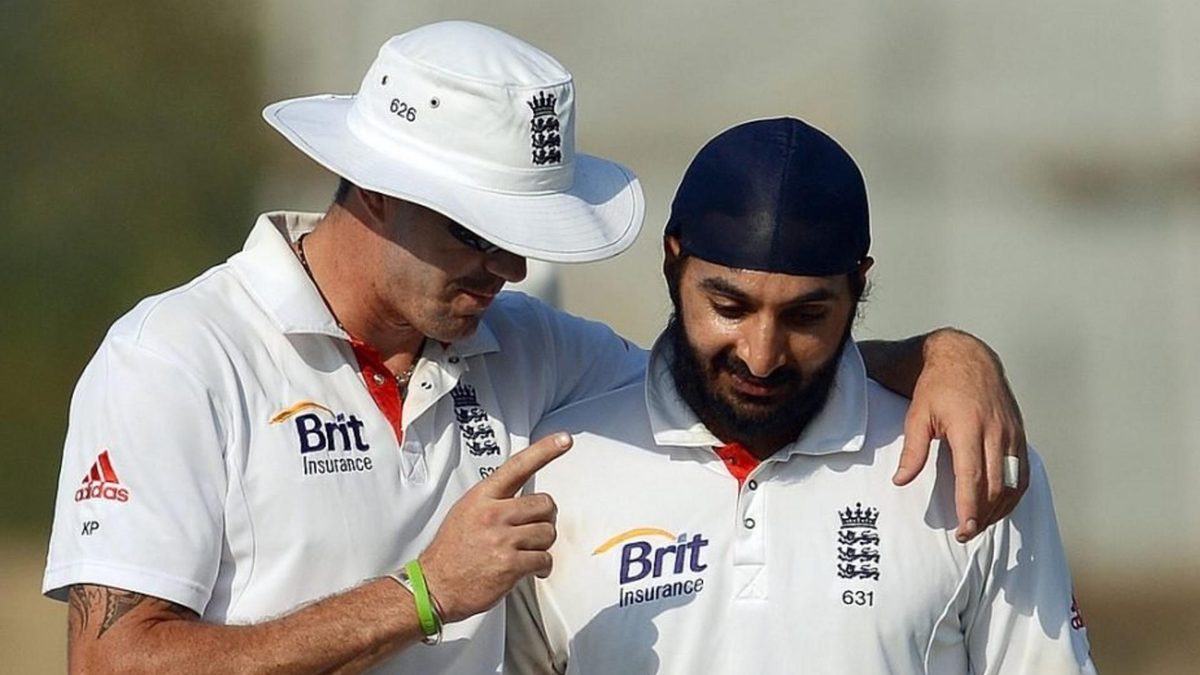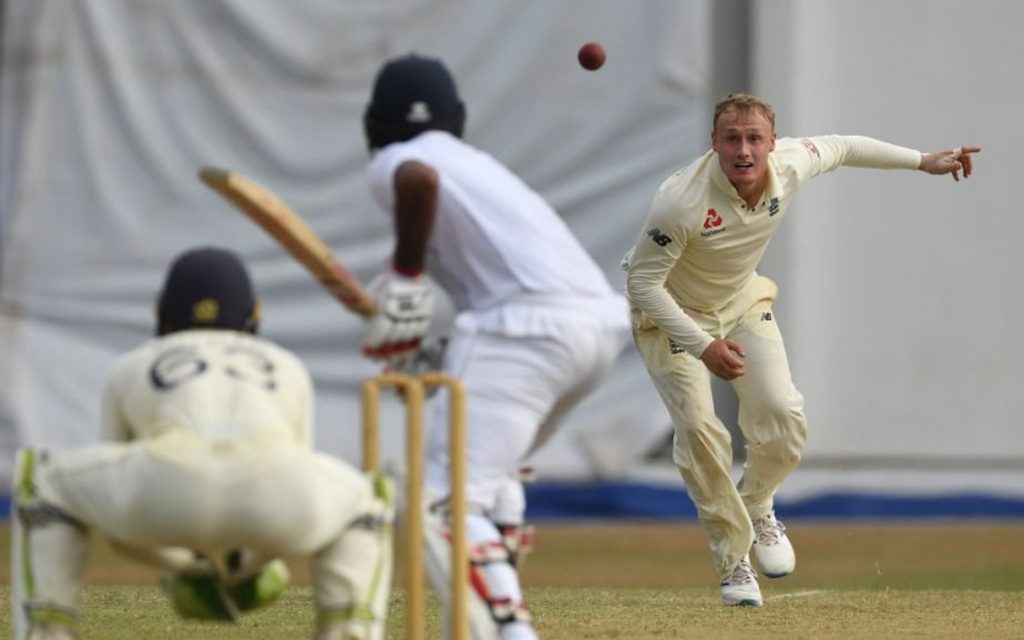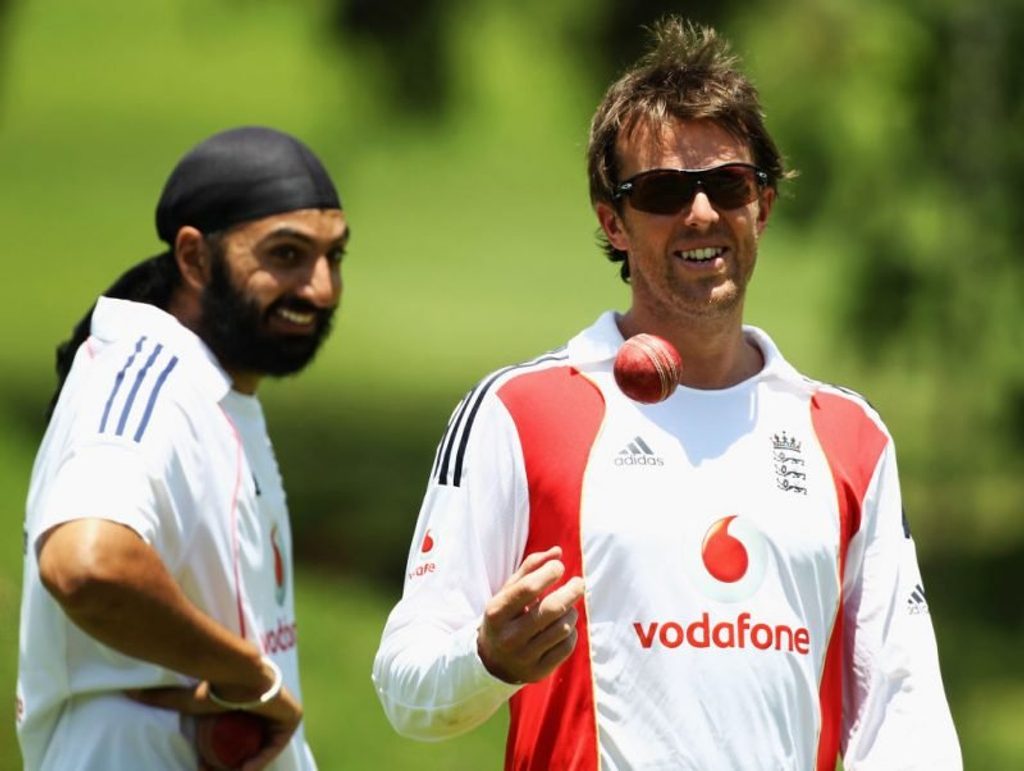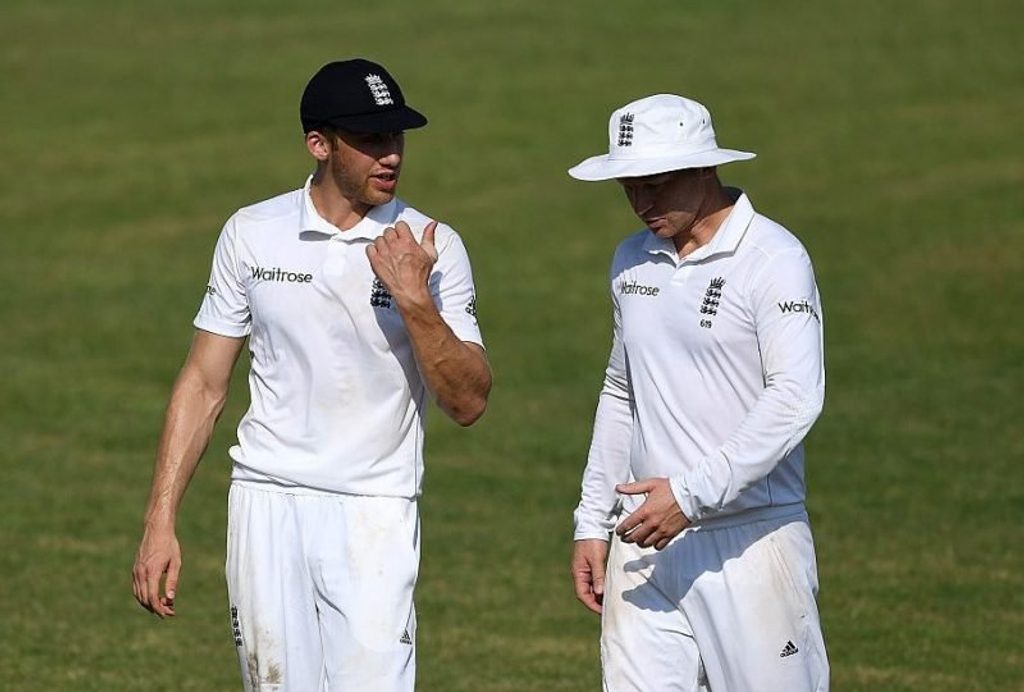
As Jack Leach, Dom Bess and Moeen Ali prepare to lock horns with India’s batsmen in their own backyard, Jo Harman speaks to four English spinners about their own experiences of a tour which can be cruelly unforgiving.
Chapter one: Ian Salisbury
Bad prawns and even worse preparation
1993
3 wickets at 74.33
So enraptured was the Lord’s crowd by the sight of a leg-spinner bowling for England that Ian Salisbury received a standing ovation before he’d even delivered a ball. It had been 21 years since England had fielded a specialist leggie in a Test match when the 22-year-old, who’d only taken up the art in his late teens, made his debut against Pakistan in 1992. He made a promising start too, snaring the early wicket of Javed Miandad, the master of spin, with a beautifully flighted leg-break and finishing with five in the match.
As tended to be the way in those times of scattergun selection, Salisbury was then dropped a match later after going wicketless and taking some tap at Old Trafford, and it was decided that his development would be best served by spending a winter in Australia with England A rather than touring India with the senior side. However, a late change of plan led to him being sent to India as a net bowler to help sharpen up the touring batsmen ahead of England’s first Test series in the country for eight years.
A couple of weeks later, having barely bowled a ball in anger for four months, he would usurp John Emburey and Phil Tufnell to play as England’s solitary spinner in front of a crowd of 100,000 at Eden Gardens, Kolkata.
“Emburey and Tufnell were the two best spinners in the country by far,” recalls Salisbury. “Those two had bowled more overs before breakfast than I had in my career. In the first Test we played four seamers, one spinner, with Hicky [Graeme Hick] as the second spinner, and they played three spinners, one seamer. One team had got it right and one team had got it wrong!”
To make a monumental challenge even more difficult, the greenhorn spinner, like several of his teammates, was struggling with illness; although thankfully for Salisbury he was suffering with flu-like symptoms rather than the explosive effects of Mike Gatting’s trademark touring diet.
“If you ate with Gatt, you got taken down. Gatt told us: ‘I’ve been to India before, what you’ve to do is eat all the local food, don’t matter what it is. Get the bug early, and then once it’s in your system you’ve got the antibodies and you lose a few kilos, so it’s always best to have a few extra when you get to India.’ They were having Chinese, prawns, but Gatt was cast iron. Imagine eating all that for a three-month trip! Gatt came back bigger than when he went.”
On the field Salisbury had to contend with a batting line-up which included the magic wrists of Mohammad Azharuddin, the destructive opener Navjot Sidhu and two young upstarts who were tipped to dominate world cricket for the next decade. Come the end of the series, Sachin Tendulkar’s average of 101 would fall just short of Vinod Kambli’s 106.
“India were not the power then that they are now, and I think people thought we could just turn up, sweep the spinners and be able to beat them,” says Salisbury. “If you think of the preparation nowadays – the homework on pitches, batsmen’s techniques, the match-ups – literally nothing is a secret. On this tour we didn’t know anything. I didn’t even know my own game.”
Thrown in at the deep end, Salisbury made the perfect start, finding Manoj Prabhakar’s edge to make a breakthrough in his first over. But he went wicketless thereafter, a masterful century from Azharuddin taking India to a commanding first-innings score before the hosts’ spin triumvirate of Anil Kumble, Venkatapathy Raju and Rajesh Chauhan ran riot, claiming 17 between them as the visitors slumped to a resounding defeat. According to Wisden, England had been beaten “physically, mentally, technically and tactically”.
The second Test in Chennai was an even more chastening affair. With captain Graham Gooch forced to miss the match after indulging in a plate of prawns with the team’s unofficial dietician (Gatting himself reported for duty but even his legendary constitution was tested, spending several overs in the dressing-room recovering), India racked up 560-6 declared and then sauntered to an innings victory, their spinners taking all but two of the wickets to fall.
The scalp of Tendulkar, finally dismissed caught and bowled for 165, was of little consolation to Salisbury. He finished with figures of 2-142 from 29 overs.
“At that stage in my career all I’d done was bowl a hard leggie and a hard wrong ’un. That’s all I had. Whereas English batsmen often couldn’t pick my wrong ’un, all of a sudden I’m coming up against players who laugh when they see a wrong ’un because they’ve basically seen it since they were born.
“What I later realised, and this is important for any spinner going to a place like India, is you need a good straight ball on a turning wicket. The key to being a good spinner is the energy you create off the pitch, and you have to be incredibly accurate. That’s what Swann and Panesar were outstanding at in 2012. They were bowling 55-58mph and Monty would get wickets with balls that didn’t spin and hit batsmen on the pad. Swann would catch the outside edge with a straight ball.
“Look at some of the spinners that have been successful in India. [Ravindra] Jadeja will attack the stumps and try and go underneath the bat with a quick ball. Anil Kumble hardly turned the ball but he bowled at great pace – straight balls with a bit of variation either way.”
Salisbury was spared the dead rubber at Mumbai which concluded the series – another innings victory for the hosts – and didn’t play another Test match in the subcontinent for seven years. But despite the toil he insists he “wouldn’t change it for the world” and says that if Matt Parkinson or Mason Crane – England’s two young leggies who are on standby on the current tour of India – receive a similar elevation in the next few weeks, they should embrace the experience.
 “For Parky I think it would be a case of, ‘Give me a crack, this is my chance, I’ll have a go’.”
“For Parky I think it would be a case of, ‘Give me a crack, this is my chance, I’ll have a go’.”
“I coached both Parky and Mason when they were 17 and they are two unbelievable talents. If Mason was to be picked I think it would be quite tough on his development. He got thrown in at the deep end [in the 2017/18 Ashes] and then had a stress fracture. But he’s a feisty character who loves competing. For Parky I think it would be a case of, ‘Give me a crack, this is my chance, I’ll have a go’. If it doesn’t work out for him – and I’d like to think that it would – then nothing’s changed.”
But for all the promise shown by Parkinson and Crane, Salisbury’s mind can’t help but wander to a world-class leg-spinner who won’t arrive in India until the white-ball contests begin.
“It’s such a shame that Adil [Rashid] is not around. If you look at him in the shorter form of the game, he’s got the big side-spinner, but the ball that’s made a big difference to him is the straight ball, ironically. It’s that good straight ball on a turning pitch. If Adil’s shoulder could hold up, he’d be so ready for Test cricket.”
Chapter two: Monty Panesar
Third time’s the charm
2006, 2008, 2012
28 wickets at 38.25, 2 five-wicket hauls, 1 ten-wicket match
By the summer of 2005, it was already clear that Monty Panesar was the most gifted spinner in England by some distance, but Duncan Fletcher’s insistence that his bowlers could contribute with the bat and in the field had held back his promotion to the Test set-up.
Come the 2006 tour of India, after a season in which the 24-year-old had taken 71 county wickets, Fletcher had little choice but to bend his own rules and throw Monty into the heat of battle at Nagpur. His entry into Test cricket was stunning, claiming India’s kingpin as his first Test wicket and earning himself instant cult-hero status with his wild celebrations.
“It can’t get better than taking your first Test wicket: the god of cricket, Sachin Tendulkar,” says Panesar. “I remember his foot slightly going at an angle towards cover and it just looked like it was plumb. I just went for it, appealed, and Aleem Dar gave it out. I couldn’t believe it. At the time it felt like I was in heaven or something. I just ran towards point and went crazy.”
 Monty Panesar made his Test debut in India
Monty Panesar made his Test debut in India
He would take just four more wickets in the three-Test series, though, upstaged by 37-year-old Shaun Udal, who nipped in with 4-17 to steal a sensational series-levelling win at the Wankhede Stadium.
Panesar was similarly nullified on his return to India two years later, taking six wickets at 50 on a tour which resulted in him losing his position as first-choice spinner to Graeme Swann.
“The Chennai Test of 2008 was a big match for me,” he says. “It was a turning deck, they needed to get 387 – I needed to win that game. I was the main spinner. I needed to outperform Swanny, mark my position and say, ‘Yep, I’m a world-class spinner’. I didn’t bowl well.
“I think sometimes you can compare yourself with the Indian spinners but then when you bowl against the Indian batsmen they’re technically better, they know how to play spin better, they cover the angles differently. As I’m bowling to some of the English players, I’m thinking I’m bowling well, I’m turning it, and then you come to the Test match and you think, ‘Wow, a good delivery isn’t even beating the bat’. That’s the biggest challenge. My best deliveries were being smothered.”
Panesar played just seven Tests over the next four years and travelled to India for England’s 2012 tour as understudy to Swann. After being bizarrely overlooked in favour of Tim Bresnan for the first Test at Ahmedabad – a crushing nine-wicket defeat – he was recalled for the second at Mumbai and, in tandem with Swann, turned the tables on India. On a crumbling pitch designed to spin from day one, Panesar and Swann took 19 wickets between them (11 falling to Monty) in a 10-wicket win.
 “We both knew how to get batsmen out”
“We both knew how to get batsmen out”
“By my third tour I really understood how to bowl on Indian pitches and I really enjoyed the challenge,” says Panesar. “The pitches had got faster because of the IPL and it suited my style of bowling. The balls were better, too. In 2006 the seam would go really soft, and you need a hard seam to get the ball to bite and turn. I felt I had the skills to adjust to those types of pitches, but it took me a while to get to that stage.
“And I absolutely loved bowling with Swanny. He was one of my favourite partners to bowl with. He knows me as a person, we played at Northants together. At the Wankhede it felt like a Northants wicket. We both knew how to get batsmen out. It was the best I’ve ever bowled.”
Panesar claimed five more victims in a seven-wicket win at Eden Gardens before England held firm in the final Test at Nagpur to clinch a historic win in Alastair Cook’s first series as captain. He and Swann had shared 37 wickets, beating India’s spinners at their own game in their own backyard.
“When I first bowled to these players, I was a bit star-struck. I felt I couldn’t get them out so I would just try to bowl dot balls. Then you grow into it and think: ‘I’m here to compete and take wickets.’ I was smarter when I returned to Test cricket. I understood conditions, batsmen’s feet movement, using angles at the crease, bowling quicker, having a cross-seamer. That made me a better bowler.”
Chapter three: Zafar Ansari and Gareth Batty
Third wheels
2016
Ansari: 3 wickets at 54.33
Batty: 0 wickets for 65 runs
England needed spin reinforcements ahead of a six-Test double-header in the subcontinent – two in Bangladesh followed by four in India – and turned to the Surrey duo of Gareth Batty and Zafar Ansari to support Moeen Ali and Adil Rashid.
Batty, then 39, had played the most recent of his seven Test matches 11 years previously, while Ansari was by his own admission struggling to rediscover the rhythm that had led to his maiden call-up a year earlier, when he had been forced to withdraw from England’s tour of UAE only hours after being selected due to a dislocated thumb.
“It was a shock, to say the least,” says Batty, who had been told he was set to be recalled for the tour of the Caribbean 18 months earlier before eventually being overlooked. “I understood my bowling a lot better than when I’d last played Test cricket but the downside was that age had taken its toll on my body, so I couldn’t do some of the things that I’d been able to do maybe even two or three years previously.”
 Zafar Ansari and Gareth Batty on England’s 2016 tour of Bangladesh
Zafar Ansari and Gareth Batty on England’s 2016 tour of Bangladesh
Ansari was also struggling with his body; thumb and back injuries restricting him to 10 first-class appearances in the 2016 season, during which he’d taken 22 wickets – half the total he’d managed in 2015.
“I just never got the consistency and rhythm back in my bowling,” he says, “but I think I was picked off the back of what I’d done in the previous couple of years. I played the second Test in Bangladesh [taking two wickets and having five chances put down off his bowling] but when I got to India I felt quite a distance away from where I wanted to be. That’s a real challenge, with the batsmen you’re bowling at and the fact that you’re under pressure to take wickets from day one.
“The biggest difference I felt that year compared to the three previous was the pace that I was bowling. Generally, I would bowl around 53-56mph but on that tour I was bowling 49-50mph, and I was really struggling to bowl any quicker than that. I’m not sure exactly why but I just didn’t have that rhythm and snap and I’m sure that made a big difference to how effective I was.”
Meanwhile, Batty had made a quietly impressive return after his decade-long hiatus, taking four wickets in a thrilling win in Chattogram, and says he was told he was being rested for the second Test in Bangladesh in order to be fresh for the series opener in India. He wasn’t seen again until the third Test in Mohali.
“It was all a bit strange, really,” says Batty. “I didn’t play in India until we were getting absolutely hammered and even then I wasn’t brought on until something like the 52nd over. I felt second string at best. The air is taken out of you a little bit. You lose that edge when you’re waiting so long.”
Having got the nod ahead of his Surrey teammate to support Moeen and Rashid, Ansari wasn’t all that much busier, bowling only 43 overs across the first and second Tests. By contrast, Moeen and Rashid had bowled 183 overs between them.
“What Batts and I had been doing for two or three years at Surrey was bowling in tandem,” says. “We knew what our roles were. I found, and I think Batts felt the same way, that when you get out to India and you’re one of three spinners, it’s a very different thing. You feel you’ve got to get it right in the first five overs because if you don’t then two spinners who are better than you are there to be brought on.
“I think on that tour all the spinners struggled with that a little bit. Building the consistency that you need in a place like India is difficult when you’re one of three spinners playing against very good batsmen on pitches which don’t always offer as much as you expect them to. It was probably frustrating at times for Moeen and Adil, too; twiddling their thumbs in the outfield while I was bowling.”
There was also a sense that Alastair Cook wasn’t in tune with the requirements of his spinners, in terms of letting them find their rhythm or setting fields that allowed them to settle into a spell.
“Spinners want seven or eight overs in a spell,” says Ansari. “Even if you’re going at three-and-a-half an over, you feel like you need that to have a chance in India and it was difficult to get those overs. What you want, and what I think England have now got with Joe Root, is someone who really backs the spinners that he has, and that’s not just in what he says, but in the way that he uses them. That’s how you want to be treated as a spinner and that’s heightened in India when the pressure’s on.”
“Captains need to really value spin,” adds Batty. “The Sri Lanka series that England won 3-0 [in 2018], which I was out there working on for talkSPORT, was the best planned I’ve ever seen an England team in the subcontinent. I’m not saying it was the best team, but it was the best planned.
“I think it showed that Joe is very aware of the thinking of spinners, and the importance of pumping their tyres up. He bowls spin himself, so he gets it. Give them an over or two, you’re not losing anything. Get them on early and you can withdraw them from the attack, that’s absolutely fine. But then as a spinner you feel like you’re in the game, that you’re there to take wickets, not just to hold up an end when the seamers are tired. It’s a very fine line, and I’m not having a go at any captain. It’s very much a feel thing, and I think Joe Root’s very good at it, I really do.”
The Mohali Test of 2016 would be Batty’s last, as England reverted to two spinners for the final match in Mumbai – another drubbing to conclude a 3-0 series loss. The tour would also signal the end of Ansari’s brief international career, the all-rounder returning home early with a back injury and retiring from professional cricket a few months later, aged 25, to pursue interests outside the game.
“I was happy to go home in the end,” Ansari says of that tour. “If I’d been bowling really well, taking lots of wickets, scoring lots of runs, it would have been different. But I was conscious that I wasn’t at my best and I wasn’t going to tear it up in the next couple of Test matches. The disappointment is the fact that tour didn’t reflect me at my best. I wasn’t the bowler I was a couple of years before that and it would have been nice to be that bowler in India.”







